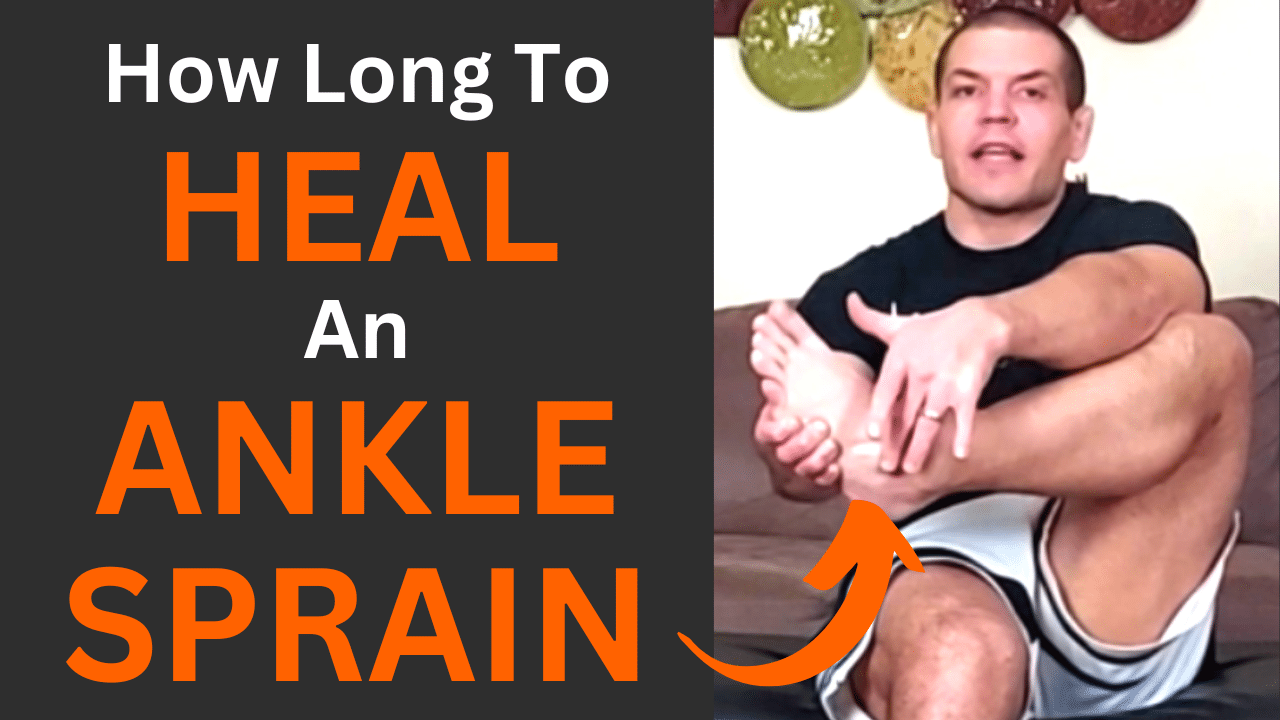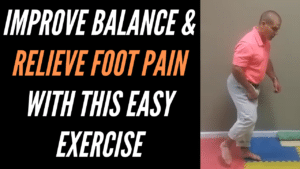If you've recently suffered from an ankle sprain, it can keep you from walking, running, or doing other sporting activities that you enjoy. You may wonder how long it will take for your ankle sprain to heal so that you can get back to doing all those things that you want to do.
Watch the video to learn how long it takes for an ankle sprain to heal. Plus, learn tips and tricks that you can use to speed up your recovery time, so you can heal your ankle sprain faster.
What Causes An Ankle Sprain?
Usually, it's caused by rolling your ankle inwards, which stretches or tears the ligaments on the outer side of the ankle.
Depending on the grade of ankle sprain, that determines how long an ankle sprain will take to heal.
Grades Of Ankle Sprains
Grade 1 (Mild) Ankle Sprain - Healing Time 1-3 Weeks
Grade 2 (Moderate) Ankle Sprain - Healing Time 4-6 weeks
Grade 3 (Severe) Ankle Sprain - Healing Time 7-12 weeks
Do I Need An X-Ray For An Ankle Sprain?
X-ray's don't show if you've torn any ligaments with an ankle sprain.
However, if you can't put weight on your ankle initially, then you do want to get an x-ray.
Ottowa Ankle Rules For X-Ray
There's a really valid rule to help you decide if you need an x-ray called the Ottawa Ankle Rules.
Essentially it says that if you don't have bony tenderness on either the outside of your ankle or the inside of your ankle or the bony part on the inside or outside of your foot, and you're able to take four steps immediately after your injury, then you very likely (99%) don't have an ankle fracture, and you don't need an x-ray for it.
However, if you can't bear weight, you do want to get an x-ray
How To Heal A Grade 1 Ankle Sprain
A mild ankle sprain or a grade one ankle sprain is where the ligaments are just stretched slightly, but they aren't torn.
There's no structural damage, and that type of ankle sprain usually recovers in one to three weeks.
During that time, there are a few things that you want to do to protect it.
In fact, the acronym is PRICE
- Protection
- Rest
- Ice
- Compression
- Elevation
Those are useful during the acute phases of the ankle sprain, but for a grade one sprain, there's usually not a lot of structural damage.
Sometimes there isn't even a whole lot of swelling, so not all of those tips necessarily apply to a grade 1 ankle sprain.
Since there's no tearing of ligaments, and so a lot of times you don't need a brace if you're able to put weight on it comfortably.
You may not need to even ice it if there's no swelling. You might not need to compress it with an Ace Wrap, and you might not need to elevate it.
So that PRICE method really might not apply that much if you just have a very mild grade one ankle sprain.
How To Heal A Grade 2 Ankle Sprain
In a grade two sprain or a moderate ankle sprain, the ligaments have been torn just a little, but not completely ruptured.
In that case, protection probably is a little bit more important.
You probably will want to use an ankle brace on it for a little while so you don't roll your ankle again while those ligaments are healing up.
Zenith Ankle Brace, Lace Up Adjustable S...
6% OffA grade two ankle sprain can take four to six weeks to heal, and during that time, you want to gradually increase the weight bearing that you're putting on the ankle.
If you can't walk without a limp for the first couple of days, you may even need to use crutches until you can walk without a limp.
Adult Crutches
$37.90 (as of July 26, 2024 11:48 GMT -05:00 - More infoProduct prices and availability are accurate as of the date/time indicated and are subject to change. Any price and availability information displayed on [relevant Amazon Site(s), as applicable] at the time of purchase will apply to the purchase of this product.)Additionally, you want to get the ankle moving as quickly as possible.
Just moving the ankle up and down and in circles can help.
You also should to stretch your calf muscles. If you can't put weight on it at first, just pulling your toes up with your hand or using a towel to pull up on them can be helpful initially.
However, as quickly as possible, you want to stretch your calf in a weightbearing position because that's functionally how we use our ankle.
After your ligaments have healed up a little bit, you also want to improve your balance on your foot.
Your ankle muscles help balance your body over top of your foot as you're walking, running, and jumping.
Additionally, the ligaments in your ankle have some proprioceptors in them. What that means is there are sensors inside the ligament that tells your brain where your ankle is in space.
When you sprain your ankle, you get those proprioceptors damaged a little bit. It takes some time for you to retrain those and help get your sense of awareness or spatial awareness where your ankle is in space so that you don't sprain your ankle again in the future.
One easy way to improve your balance is just practicing balancing on one leg.
If that gets really easy to do, then you can start using uneven surfaces, either balance boards, balance pads, standing on top of a pillow if you're doing it at home.
As you get further out from injury and your ankle heals further, then you want to get back into higher impact activity.
That may mean getting back into jogging or running or jumping if those are things that you do.
If you're not someone who does those things, then just getting back into walking may be all you need to do.
How To Heal A Grade 3 Ankle Sprain
It can take upto 12 weeks for severe ankle sprain to recover.
If you've had a severe ankle sprain where you've torn the ligaments completely, you're probably going to have a longer protection period, probably a couple of weeks inside an ankle brace, maybe even a walking boot if it's really bad.
Once you get out of the boot, then you start going through those steps like I mentioned for a grade two ankle sprain. It's just going to take you longer to hit those landmarks:
- Progressive Weightbearing
- Getting your mobility back
- Working on your balance
- Getting back into higher impact activities like walking, running, jumping, and things like that.
The final level that I didn't mention earlier is after you've started running and jumping again, then you want to get into directional changes if you're in sports.
Doing cutting and pivoting activities would kind of be the last stage where you're most likely to sprain your ankle or roll your ankle again when you're doing a cutting or pivoting type activity.
How To Heal Chronic Ankle Pain
Now finally, what if you have ankle pain that's lasted longer than it should? Let's say you've gone past 12 weeks, and you're still having pain in your ankle. What do you do then?
By 12 weeks, your ligament should be very well healed up anatomically.
However, if you've had a severe ankle sprain where you've torn ligaments and maybe got some joints out of place, there's a joint up by your knee that gets injured.
In that case, it can get a nerve called your fibular nerve overly sensitized, and that can cause some lasting pain even after the tissues have still healed up.
If your tissues have healed, but you're still getting signals telling your brain that something's wrong down there, it's very likely that that nerves have gotten overly sensitized.
At that point, you definitely want to seek out treatment for your ankle sprain.
Seeing a physical therapist can help figure out if there are still some joint dysfunctions in your ankle to help you get your ankle moving again.
Often chronic ankle pain happens when an ankle sprain was poorly treated at the very outset. Maybe you didn't move it enough initially or you were told to be in a brace or a walking boot and not to do anything.
Sometimes, that fear of movement can actually make those nerves a little bit more sensitive.
Usually, ankle pain that's lasted longer than it should and become chronic past 12 weeks usually has to do with sensitive nerves.
Need Treatment For An Ankle Sprain?
If you have an ankle sprain that you either want to get moving quickly, or if you have an ankle sprain that's lasted past 12 weeks and you're still suffering, we'd be happy to help you find out what's wrong and what you need to do to get your ankle moving again so you can get back to all the activities you enjoy.
Just tap the button below to request an appointment with one of our specialist physical therapists to find out how we can help.
Have other pains when you wake up? You might enjoy this post:
Why Does My Ankle Hurt When I Wake Up?









